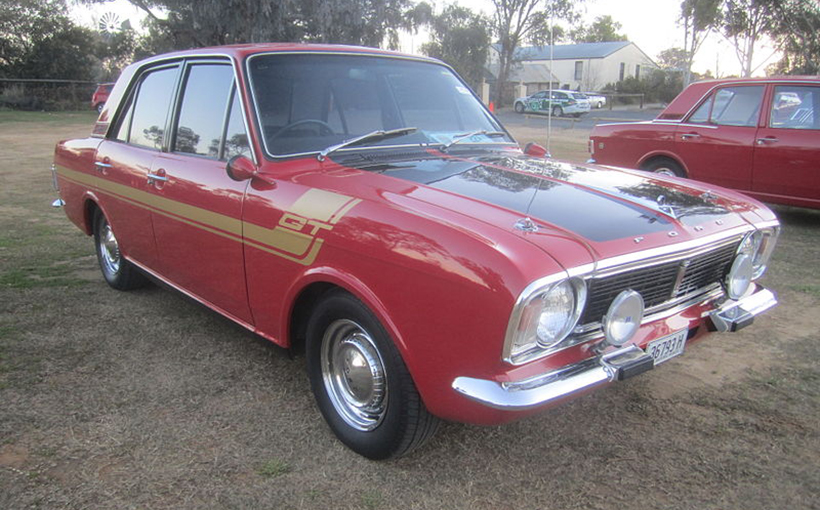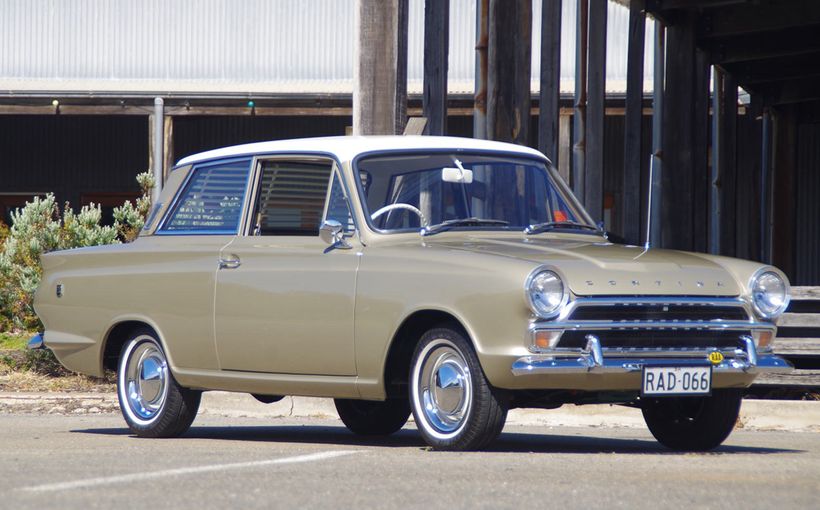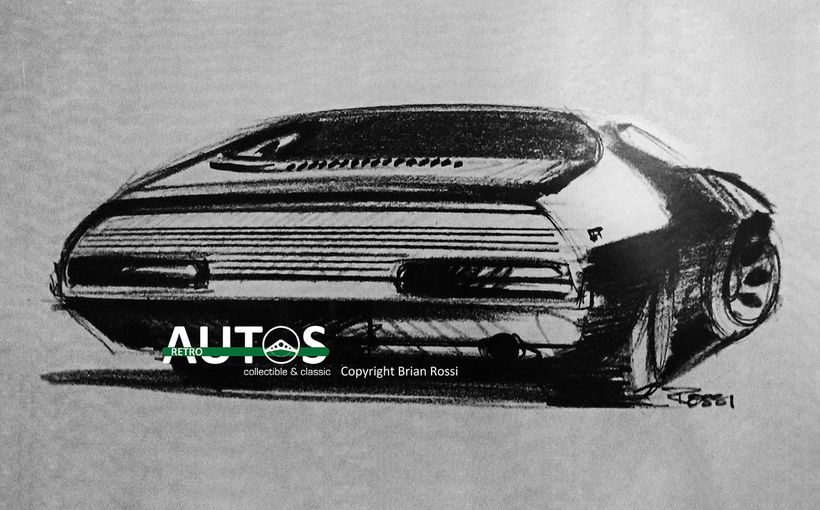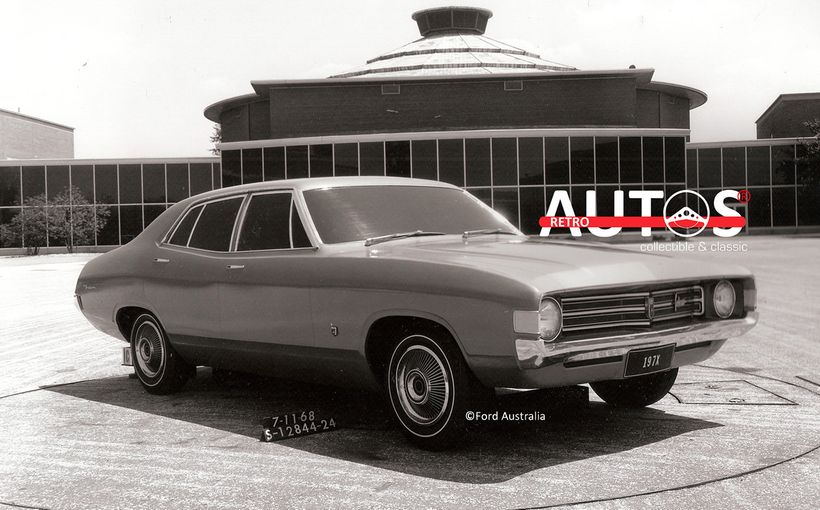1967-71 Ford Cortina Mk II: Dagenham Dustbin or the Next Model T?

As Ford Australia tried to remove the Cortina GT further from its British family car origins, the Australian GT from 1969 became the most aggressively-packaged Cortina Mk II in the world, eclipsing even the tame Cortina-Lotus packaging. Ford was on a mission to leverage its Falcon GT success to sell all GT models and even applied the SuperRoo decals across its British GT range later. (Photo from commons.wikimedia.org)
1967-71 Ford Cortina Mk II: Dagenham Dustbin or the Next Model T?
Defining a replacement for the first Cortina after it sold over one million and set a new British record for exports was no easy task. Ford delivered the Mark II, a Cortina that was more of the same but with a little more of everything. In the process, the Cortina Mark II established a new global value baseline for family and commercial use in much the same way as the original Model T.
After it was placed in local production from August 1967 under the 95 per cent local content plan almost a year after its October 1966 UK launch, the Mark II was the biggest car for the money on the Australian market.

This survivor example of a late model Mark II Cortina highlights the local presentation at 440 level. The local grille didn’t follow UK changes but the interior gained the new later dash style. Note trim strip on top of rear flanks which was an Australian touch. (Photo from gumtree.com.au)
The Mark II’s local timing was impeccable, arriving just as second car ownership exploded in Australia and the first baby boomers were ready to buy a cheap and frugal family car. The unique Aussie base level 220, launched initially as a local Anglia replacement based on the facelifted Mark I Cortina, re-appeared as a bigger and more powerful Mark II. It was priced between the much smaller base Torana and Torana S.
Even at 220 level, the Mark II Cortina matched the boot of an EH Holden. Its front styling, based on the 1966 US Falcon, soon lined-up at mid-range level with the local 1968 XT Falcon after it arrived with the US 1966 front and the Cortina’s chrome strip running along the top of the body sides.
Yet Ford burnt its early Mark II buyers in one of the most poorly timed upgrades in the local industry’s history. Not even four months after release, the Mark II’s carryover 1500 pushrod engine was replaced by the far more efficient and powerful 1600 cross-flow engine effective from January 1968. Even worse, the brand new 1300 engine launched in the new 220 Mark II was also upgraded with a similar cross flow head and almost closed the gap over the previous 1.5-litre models for a fraction of the price.

The switch to cross-flow 1300 and 1600 engines occurred in the UK barely one month after the new Mark II range was launched in Australia. Within 4 months of this local launch, the first local 1967 Mark II was made obsolete on the 1968 local introduction of these new engines. They made a huge difference.
It was bad enough that these benchmark new engines, which would remain current for at least a decade, arrived in September 1967, just a year after the UK’s Mark II release. For Ford Australia to release the new Mark II range locally with the old engines, just one month before the new engines appeared in the UK, generated outrage in the motoring press and the buying public.
Its impact on early buyers of the top drawer Mark II Cortina GT and their extra investment was even greater as the new 1600 cross-flow bumped power up from 83.5bhp/62kW to 93bhp/69kW with a boost in flexibility and response. The standing quarter was cut from 19.5 to 18.8 seconds, enough for a change of character. By 1969, Ford Australia was re-packaging the GT as a unique local model to restore credibility.
The most common explanation for this poor timing was that the Mark II was ready for release but its new cross-flow engines were not. The projected sales loss from holding back the Mark II range for another year forced Ford’s hand to release the new car then add the new engines later, a decision that worked for the UK market but not Australia. It was not unusual in the 1960s to stagger mechanical and body changes so the buyer didn’t end up with too many new car gremlins.

Even if this face was a logical progression of the Mark I with hints of Mustang, it looked too sad and was dropped before it reached production. Final front was based on 1966 US Falcon although side lights similar to later Renault 10 survived and made the car look narrow.
Overall, the Cortina Mark II also brought extra weight and a subsequent loss of sportiness compared to the Mark I, something that Ford exploited by adding the Escort in late 1967, with export markets following later. This British Ford range with the Mark II Cortina as the prize contender, topped by the Capri and the Cortina-based Corsair, was so effective that British Leyland was soon recruiting the Ford people behind it, so they could match it.
The Cortina Mark II also became the foundation for the Hyundai car company after production commenced in South Korea in 1968.

Local Mark II brochure highlighted dilemma created by new British repmobile and family car positioning of the Cortina. Not as sporty as the previous model, it was presented as the perfect starter family car for young drivers. In local colours, it also made the perfect second car to a ZB Fairlane or XT Fairmont as the shared Ford DNA was much stronger than before.
The Mark II Brief
How do you update a car still selling up a storm on the domestic market just as export markets like Australia started to taper off? The Mark I Cortina, with its 1950s “headlights above the grille” styling, still looked perfectly at home against the Morris 1100 and current Hillmans in 1966.
Yet most export markets had been exposed to the latest “headlights in the grille” front styling since 1960. It was a distinction not lost on the Japanese as the latest Isuzu Bellett, Datsun Bluebird and Toyota Corona switched to the new style within two years of the first Cortina’s release.
The strategy was to leave what didn’t need updating, then refine or replace what did. This dictated a reskin of the original platform within the Mark I wheelbase and length.
Because the Mustang was selling up a storm, it was decided that Ford’s global economy cars should plug into Mustang success and style. This ensured a family resemblance in showrooms like Australia and left the door open for exports to the US.
Under Roy Haynes, who had made his name as an interior designer for Ford’s body supplier Briggs, two Mark II proposals were developed. One had a much more pronounced hip line, rising and falling over the rear wheel arch like GM’s latest models. This was rejected but elements of it surfaced in the Escort Mark I.
Haynes’ own proposal won out after he specified deeper glass, a straighter hip line and squared-off sides. Haynes has since claimed that the rear quarters and boot were inspired by the Mustang which might be true except Ford’s flat economy car pressings left nothing of the Mustang’s slender rear end with its small tail fins flanking the boot lid.

At mid-range 440 level, the wheels and tyres on the local Cortina MK II looked way too small. Although the styling had all the right ingredients, the lack of detail and the flat surfaces in the panels looked much cheaper than Australians were used to in their family cars. Flush, wraparound tail lights were a last minute addition after former Holden design chief Leo Pruneau pressured British component suppliers into making specific lights for his HB Viva/Torana when he was at Vauxhall instead of a variation of the usual off-the-shelf lights. (Photo from gumtree.com.au)
Although the Cortina Mark II didn’t quite end up looking like a dust bin, it did look like a dustpan as the front section looked too small for the rear. This was especially evident in Australia where local Falcons followed the same styling theme but looked much sportier, even though they were much bigger. The Mark II boot always looked like it was too big and would fall off the back of the body if you overloaded it. It was an impression backed by reality as a minor rear end collision would cause it to droop.
Initial proposals featured a Mustang-style grille similar to that fitted to the Datsun 1200 Coupe. It made the Mark II look sillier than the front that went into production. Both front proposals were compromised by the large indicator/parking light units outboard of the headlights which placed the headlights almost inside the bonnet opening.

The XT Falcon which shared local Ford showrooms with the Mark II Cortina highlighted the styling links between the two models. As long as the price was right, it helped the Cortina but the XT Falcon, drawing on more elaborate US panels, looked a far better car than the relatively small price difference suggested. (Photo from commons.wikimedia.org)
Despite Ford’a latest Falcon grille style, as shared with the XT Falcon in Australia, the Mark II front always looked too narrow. This was compounded by the stock skinny wheels, excess body overhang and empty space inside the wheel arches.
The visible front lower control arms hanging under the front and the large area of daylight above them also generated the impression that the standard Cortina was an empty box slapped over the top of the old one. Extra ride height on Australian cars added to this. It was also an impression reinforced by the cabin starkness in every model except the GT.
The Mark II dash design was however inspiring, and good enough to form the basis for the dash of the Australian Bolwell Nagari sports car. The large eyeball vents in the dash with their extra 25 per cent capacity were conspicuous by their absence on big Australian family cars that needed them far more than the Cortina, including the Falcon. The Mark II quarter vents were now fixed. Ironically, this Aeroflow ventilation system introduced at the Mark I facelift was designed in the UK by Australian Ken Teesdale.

This side profile shot of an Australian 440 highlights the slabbiness of the Mark II sides and the overhang inside the wheel arches creating the impression that it was a cheap car compared to the Falcon. It was not a problem in the UK where you couldn’t make the comparison as readily. (Photo from justcommodores.com.au)
The bigger, stronger body added over 2 inches/51mm in shoulder room, allowed a bigger fuel tank (up from 8 gallons/36 litres to 10 gallons/45 litres) and a bigger boot at the expense of an extra 70lb/32kg in overall weight, more in the upper models. The deep sides allowed the spare wheel to be tucked vertically into the left hand side rear wing where it could be accessed without emptying the boot. In the process, it helped re-define the Cortina as Britain’s most popular fleet, family and rental car, for another sales record of over a million and even higher than the Mark I.
It was exported to the US as the Model C, a deliberate play on the Model T, A and B heritage and promptly sold well over projections every year until it was withdrawn. After 1968, stringent new emissions and safety standards made life tougher for the Cortina. By 1969, US exports ground to a halt once the Ford Maverick gave Americans a new Ford compact of their own.

Late model Australian front with FORD letters on the bonnet highlights how far from the body sides all Mark II headlights were placed contributing to the incorrect impression that the Mark II was narrow-gutted. (Photo from justcommodores.com.au)
In Australia, this new positioning wasn’t entirely successful as the fleet/family car role was already owned by the far more desirable Falcon in the local Ford range leaving the Cortina vulnerable if younger buyers wanted something sportier.

This superb XT Falcon 500 survivor car highlights how the US 1966 Falcon grille, which inspired the production Mark II Cortina front, was held over until 1968 in Australia where it almost coincided with the Mark II Cortina release. Note the XT’s full width grille and headlight placement plus the curvature in the sides. (Photo from xr-xt falcon Facebook site)
By 1968, the local Mark II Cortina like the VW Beetle, was up against serious opposition from the Datsun 1600 and Toyota Corona. By the close of 1969, young Australian buyers were being wooed by the dramatic new Holden LC Torana 6 that offered up to the minute looks and six-cylinder grunt in a similar-sized package.
These developments explain the sudden emergence of the SuperRoo Cortina GT package and the factory parts catalogue that allowed owners to access extra performance.

The Mark II Cortina dash was quite imposing for a cheap car. This is the later local 440 sedan with its upgraded remote shift gearbox, carpet, central handbrake and black steering wheel. (Photo from gumtree.com.au)
Under the Skin
Because the Mark I Cortina was rushed into production, there wasn’t time to develop extra bump compliance in the MacPherson strut front suspension for radial tyres. The leaf spring live axle geometry was also a compromise and there were those within Ford who thought the roll oversteer it generated was excessive.
By adding extra compliance in the front rubber mounting bushes and adding bump stops to the front struts, the Mark II spring rates could be made softer and more progressive, a welcome development for Australian buyers as the ride from the Mark I front end could be quite harsh.
The rear geometry was revised by altering the mounting points for the leaf springs then making them a permanent fixture when the floorpan was being revised. For the Mark II, Ford’s British engineers had the luxury of using different leaf spring mounting brackets on a Mark I development car to optimize the location for the production items.
The front coil springs were mounted at an angle to the strut to reduce friction. To counter the extra shoulder room and carrying capacity, Ford wisely increased the front track by 2.5 in/63.5mm and the rear track by 1.5 in/38.1mm, a move which improved stability.
Steering remained recirculating ball but the turning circle was cut by 48 ins/1219mm back to 30 feet/9.1 metres with 3.5 turns lock to lock. Although it was slightly heavier than the Mark I, the still relatively light steering along with the standard front disc brakes were standout features at the price.

The Australian 1969 Cortina GT upgrade also featured the latest Cortina GT dash with the extra instruments mounted under the dash padding. It was almost indistinguishable from the Cortina-Lotus version.
It was a successful engineering program as the Mark II was praised for its more refined ride and safer handling with mild understeer if you pushed it too hard. The big drawback was the cheap tyre specification at entry level with skinny 5.20-13 crossplies while the upper level 5.60-13 was little better. More than any single item, the low tyre specification cheapened the entire presentation as the bigger body looked like it needed extra rubber.
For the Mark II release, the Mark I’s 1198cc 1200 engine was totally re-engineered with a new block, a four throw crankshaft and five bearings after it was stretched to 1297cc. It shared the 1500 bore. A heavier flywheel was meant to smooth out the torque delivery and make it more flexible but the heavier Mark II took its toll.
Despite a 5bhp/3.7kW increase, the 1300 struggled in the Mark II body requiring 22 seconds to cover the standing quarter. Top speed pulled up at 76mph/122km/h which left little for cruising or overtaking under Australia’s open speed limits at the time. This was equivalent to a Mini Deluxe or VW 1300 which didn’t encourage the same loads as the Cortina. The 1500 carried over unchanged with 65bhp/48.5kW in standard form.
Poor carryover gear ratios didn’t help early British Mark IIs but the close-ratio box from the Corsair GT was introduced across the Cortina range before the Mark II was launched in Australia. Early mainstream models had a slick direct floor shift when a column shift was not fitted while the GT had a remote shift. Ratios were the same for the 1300 and 1500 but a much shorter rear axle ratio in the 1300, making the 1500 much more relaxed if not much faster. Clutch operation switched from hydraulic to mechanical.
It was in this context that the new cross-flow heads which arrived in Australia for 1968 were a huge advance. Placing the inlet and exhaust ports on the opposite sides not only encouraged a much straighter and more efficient gas flow, the pent-roof design of the new heads allowed bigger valves. Along with the new bowl in the crown piston design, the spark plug could also be relocated more centrally.

This is the premium British Mark II dash as featured on the icon 1600E luxury model not sold in Australia as its price would have crossed into local Fairmont and Capri territory. Ford Australia instead offered the wood dash as part of an L pack that could be ordered as a local 440 or GT. (Photo from gopixpic.com)
The overall effect was an instant 10 per cent boost in power across the range with similar gains in fuel economy and flexibility. The 1500 grew into 1599cc, almost a full 1600 with a deeper cylinder block and longer stroke but the same bore. This new 1600 was not related to the fettled 1500 blocks used by Lotus for the 1600 Twin Cam engines. The 1300 jumped from 57.5 bhp/43kW to 63bhp/47kW. This highlights why the 1500’s 65 bhp/48.5kW had to be boosted to the 1600’s 75 bhp/56kW which reflected the capacity increase and the new head.
Torque was also higher and more consistent as the engine revved more easily. The GT’s 93bhp/69kW could at last exploit the GT’s bigger front disc and rear drum brakes, the taller rear axle ratio, slightly fatter tyres, firmer suspension and extra rear axle location. There were also other upgrades at this time to mark the new engines including a clock in the GT’s centre console, a switch from black to white steering wheels in Australia and carpet in the mid-range models.

The later version of the Mark II Cortina-Lotus dash shared with the British GT. Compare it with the Australian Cortina GT above from the same year. (Photo from lotus-cortina.com)
The Mark II GT was also much closer to a Lotus-Cortina and made the jump to the Lotus Twin Cam engine a much easier and more accessible process.

Because the Cortina-Lotus Mark II was so plain on release with only the wide wheels and extra black in the grille to identify it, Ford added the side flash for the launch then had to offer it as an option. (Photo from stationaryengine.org)
Cortina-Lotus Mark II
Ford withdrew the Lotus-Cortina between October 1966 and March 1967, at a point when there was still plenty of track momentum in the old one. The last minute plan to squeeze the Twin Cam into the Escort to create the true Lotus-Cortina road and competition replacement allowed an equally late change in emphasis for the Mark II Cortina version.
Because the Mark II’s increase in size and extra weight were perceived to be more detrimental than they actually were, Ford was under pressure to re-establish the Mark II Cortina’s credentials before switching to the Escort. This was especially the case in export markets where the Escort was still some years away.
Lotus had vetoed its final assembly of the Lotus-Cortina by taking advantage of government incentives to move its operations from Cheshunt to Hethel, which was too far away from Ford’s Dagenham plant for partially-built cars to be transported there and back on completion.
The solution was for Ford to refine the GT specification with a special dash and similar suspension so that the Lotus-Cortina became a simple engine option with full assembly completed by Ford, a process already underway after the Mark I facelift. The Mark II was called the Cortina-Lotus to highlight the reversal of assembly input. It was then a logical progression to call the later Escort version, the Escort Twin-Cam, although the engine itself always carried Lotus identification. After the Escort came on board, the Cortina-Lotus was re-named the Cortina Twin-Cam as they were both a product of the same process.

The Cortina-Lotus was rebadged as the Cortina Twin Cam at the end of its model life to bring it in line with the Escort Twin Cam. (Photo from kitfoster.com)
The engine was boosted to a real 115bhp/86kW in base specification and now topped by a large new air-cleaner that looked like a large twin pipe muffler. This in fact was its exact role; to silence the intake roar and throaty sucking sounds from the pair of noisy twin-throat carburetors. Although it cost the Cortina-Lotus much of its character, the silenced engine gained fans for its extra refinement which was more in keeping with its new role as a factory engine option.
The shift of final assembly back to Ford allowed Lotus to bring the complete assembly of the twin-cam engine back into Lotus, including the heads which had previously been assembled by J. A. Prestwich of JAP motorcycle fame.
This one-stop relationship allowed Ford to refine oil sealing issues, develop a better throttle mechanism and improve piston durability. The chassis development of the Mark II Cortina-Lotus package had a greater emphasis on rallying as Ford felt the Cortina had already proven its credentials as a race car. Rallying was considered a far better context to demonstrate the Mark II’s everyday improvements.

Familiar Lotus twin-cam engine was refined for the Mark II application as a more palatable engine option, not a competition special. This Lotus engine is fitted to the later Mark II engine bay modified for Ford’s cross flow engines. (Photo from lotus-cortina.com)
Because weight had increased from the original Lotus Cortina’s 16.3cwt/828kg to 17.8 cwt/904kg, twice the increase of other Mark II models, the boost to a consistent 115bhp/86kW baseline specification was essential.
The tail shaft was now two-piece to cut vibration from the twin-cam’s higher engine speeds and the new close-ratio gearbox, from the bigger Corsair 2000E, was mated to a 3.77:1 final drive. A stronger 8 inch/203mm clutch with lighter pedal pressures was essential with the extra weight. The Mark II’s new self-adjusting brakes including the GT’s bigger 9.6in/244mm front discs were standard.
Suspension shadowed the GT with stiffer springs at the front and a smaller anti-roll bar, at the rear, combined with softer rear springs and twin radius rods, all with a ride height lowered by one inch/25.4mm. This allowed the spare to remain in its normal position, unlike the early Mark I’s Chapman suspension. The battery was again moved into the boot to allow room for the brake servo displaced by the large Weber carburetors.
The cabin was all Cortina GT including the dash and black steering wheel except the tacho read to 8000rpm (even if the cutout hosed the fire out at 6500) and the speedo up to 140 mph/225km/h. The exterior was also Cortina GT with only extra black paint in the grille, tiny Lotus badges on the rear quarters and wide rims giving the game away. If you tried to explain why visiting British executives could never understand the wild differentiation on Aussie muscle cars from this era, the explanation would start here.
The Cortina-Lotus as a GT upgrade could be ordered in normal GT colours, a problem for those launching the new model. The decision was made to replicate the green side stripes on the white launch examples even if there was no body pressing to frame it. It was offered as an option.

This photo highlights the plain-wrapper shift in emphasis for the Mark II Cortina-Lotus and the massive difference in presentation between the post-1969 Aussie Cortina GT. (Photo from modifiedcars.com)
The new Cortina-Lotus was promoted as a 1068 pound alternative to a 2000 pound Italian sports car with the same on paper specification, a valid comparison not lost on British buyers. It was a top seller after the extra refinement and vice-free handling were widely praised and along with the GT, was contributing to 30 per cent of Cortina production at one point. Like the Falcon GT in Australia, plain wrapper versions were popular with the British constabulary for certain roles. A four door version was built in very limited numbers for special purposes.
Upgrades that came with the cross-flow engine on everyday Mark IIs impacted on the Cortina-Lotus at the end of 1967 including a leather-wrapped alloy spoke steering wheel, the revised centre console with clock and a new Twin-Cam badge that replaced the Lotus badge on the boot, to bring it into line with the Escort. A single rail gearshift arrived in late 1968. For 1969, a new fully padded safety dash with integrated dials under the padding and an extended centre console were added.
Compared to the 3000 (give or take) Mark I Lotus-Cortina examples built, just over 4000 Mark II examples were completed by the time production ended in July 1970, a healthy figure given that the more competitive and sportier Escort Twin Cam had been around since early 1968. It is worth noting that while Ford Australia never offered a Lotus-Cortina, local versions of the Escort Twin-Cam were offered.

The premium model in the British Cortina range was the 1600E which was higher specced than the Cortina-Lotus except under the bonnet. It was not offered in Australia but canny local buyers could build one by adding the L spec to the Cortina GT and ordering the Rostyle wheels. (Photo from carandclassic.co.uk)
The biggest competition for the Cortina-Lotus was the Savage V6 version of the Mark II Cortina built by former Ford personnel with all the improvements that Ford had developed if it had gone into production. It was tacitly approved by Ford.
A similar but tougher version developed by Basil Green in South Africa, the Cortina Perana V6 was not only approved by Ford but was offered as a new car with warranty in response to the growing competition profile of the locally-built Aussie Monaro in South Africa. It hit legend status after beating the Monaros in 1970 at Kyalami.
Although the Cortina-Lotus Mark II marked the end of the line for sporty Cortinas, its tame presentation left room for a much wilder looking Mark II Cortina in Australia.

Another rare Australian survivor car, this one highlights the unique Australian specification of the late model mid-range 440 with the L option. The side stripes, full wheel covers and wood dash are the key distinguishing features but closer inspection reveals the deletion of the local rear quarter trim piece and the addition of the chrome sill strip. (Photo from tradeuniquecars.com.au)
The Aussie Cortinas
The local Mark II Cortinas broadly followed the UK models except the local range was presented as a base 220 two door stripper model with 1300, a two door 240 with 1500 and later 1600 and a four door 440 with 1500 and later 1600 with a choice of bench seat/column shift or bucket seats/floor shift. There were ongoing upgrades including carpet on the 240/440 and remote floor change gearbox upgrades on all models.
The chrome strip running along the top of the rear quarters (but not on the 220 or GT) was unique to Aussie examples. It was a link to the XT Falcon which featured a full length version of the same theme not shared by US Falcons.

Another view of the late model Australian GT highlights how local designers attempted to break up the slabby panels with extra detail. At best, they could only partially succeed even if they did create a four cylinder sporty model that stood out more than most for the price.
The underwhelming Mark II GT presentation was an ongoing concern. Ford Australia was able to draw on extra chrome side accents for the Mark I GT not on the British GT but the wheel arch and sill accents and extra chrome on the door frames on the Mark II version were way too subtle.
That all changed with a key April 1969 upgrade. To use Ford’s words, the GT now “has the spectacular appearance of a “go” machine, Le Mans anti-glare hood panels, hood lock pins, GT side stripes and insignia, quartz iodine long range driving lights, fat radial tyres on 5 in rims (4 in on other models).” There were also racing style exterior mirrors and the front bumpers had been split, Lotus-Cortina style into bumperettes with small rubber faced overriders. The chrome accents on the wheel arches and sills of earlier GT models continued initially and the tail gained a black section that made the GT look sportier from the rear.

The best Mark II Cortina presentation was possibly the South African Perana V6 version which combined the best of the 1600E with a Camaro-style front stripe that seemed to suit the car.
Mechanically, it was similar to the previous 1600 GT Mark II. Even the rear radius arms since deleted from the British GT in 1968 were still listed and now shared only with the British Cortina-Lotus and 1600E.
The entire presentation and promotion were geared to the Mark II’s local rally successes. Implicit in the above promotion was that the GT didn’t have the appearance of a “go” machine before! SuperRoo decals were added shortly after (as for Escort and Capri GT models) under local Ford competition boss Al Turner’s campaign to link all GT successes under a single SuperRoo identity.
Inside, the GT clock had gone from the centre console which had increased in size and was replaced by a large GT badge. The new dash was based on the new British safety design with the extra gauges mounted under the dash padding, not above it as in previous GT models. The leather-wrapped steering wheel was similar to the drilled spoke item on later Cortina-Lotus models and there was a new vinyl dash covering. It was a dramatic boost in presentation not equalled by the GT or Cortina-Lotus in the British market and would have given the final Cortina Twin Cams an equally welcome lift.

This privately-owned Mark II Cortina 440 highlighted what was really needed to break up the large expanse of Cortina sheet metal. It involved little more than a set of steel wheels that filled the wheel arches but on this car, they needed to be there…
Because the Mark II Cortina still had a long two years to go on the local market against tough new competition, it didn’t end there. Ford’s new hero Mark II model in the UK was the 1600E luxury model with GT mechanicals, lowered Lotus-Cortina suspension, Rover-style wood and pleated bucket seat interior and the Capri’s classy Rostyle wheels.
Because a local 1600E would have been knocking on the door of local Fairmont pricing, Ford released two more unique local packages drawing on 1600E features in August 1969. A new 240/440 L was offered with a wood dash (but not the GT instruments), upgraded seats, local full wheel covers and extra chrome below the doors replacing the chrome on the rear quarters. The revised GT was also offered as a special L version with the 1600E's wood dash, upgraded L seats with Fairmont trim and the L full wheel covers. The GT L was often seen with a vinyl roof, the Capri’s full wheel covers or the optional Rostyle wheels.

In one of the most understated engine swaps seen in a while, this plain wrapper Mark II was packing a small block Windsor V8 in a suitably reinforced engine bay. If Ford Australia wasn’t pre-occupied with selling Falcons, this would have been just the weapon to silence pesky XU-1 Toranas and leaves all Cortina fans dreaming of what could have been.
All three premium models are desirable as they were unique to the Australian market and further removed the Mark II from its cut price Dagenham origins. Then in typical Ford style, the exclusive top shelf L badge was applied to the stripper version of the TC Cortina as soon as it replaced the local Cortina Mark II range in August 1971. The more things change, the more they stay the same!
British Reference: Ford Cortina The Complete History by Russell Hayes









